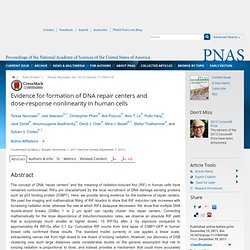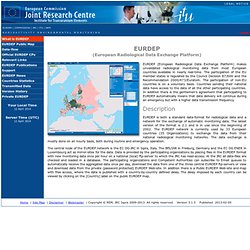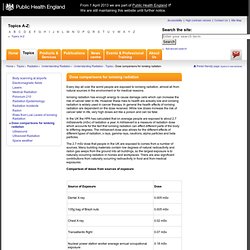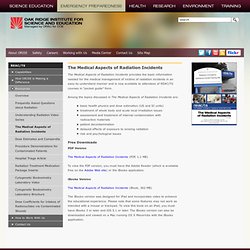

One Per Cent: DIY Geiger counter smartphone app to measure radiation. Kat Austen, CultureLab editor In the wake of Japan's Fukushima disaster, amidst a climate of general mistrust of government radiation data, a number of crowdsourced initiatives for mapping radiation levels sprang up, such as Japan Geigermap, in which radiation readings from citizens are aggregated and displayed online using a web service called pachube.

But most Geiger counters for personal use cost around $200, prohibiting many from measuring radiation for themselves. That's where non-profit organisation radiation-watch.org has stepped in. They have devised a way for people to construct their own smartphone-compatible Geiger counter at home. Pocket Geiger uses 8 photodiodes to detect the radiation, aluminium foil to screen alpha and beta particles, and a plastic "Frisk" sweet box for the housing.
The project has now grown to over 10,000 users, but due to privacy issues the maps can only be viewed within the radiation-watch.org community.
New take on impacts of low dose radiation. Public release date: 20-Dec-2011 [ Print | E-mail Share ] [ Close Window ] Contact: Lynn Yarrislcyarris@lbl.gov 510-486-5375DOE/Lawrence Berkeley National Laboratory Researchers with the U.S.

Evidence for formation of DNA repair centers and dose-response nonlinearity in human cells. Author Affiliations Contributed by Mina J.

Bissell, November 1, 2011 (sent for review September 7, 2011) Abstract. What is EURDEP. EURDEP (EUropean Radiological Data Exchange Platform) makes unvalidated radiological monitoring data from most European countries available in nearly real-time.

The participation of the EU member states is regulated by the Council Decision 87/600 and the Recommendation 2000/473/Euratom. The participation of non-EU countries is on a voluntary basis. Countries sending their national data have access to the data of all the other participating countries. In addition there is the gentlemen’s agreement that participating to EURDEP automatically means that data delivery will continue during an emergency but with a higher data transmission frequency.
Description EURDEP is both a standard data-format for radiological data and a network for the exchange of automatic monitoring data. A METHOD TO CHARACTERISE SITE, URBAN AND REGIONAL AMBIENT BACKGROUND RADIATION. RDTN.ORG. Remnet (JPN) 緊急被ばく医療研修のホームページ. IAEA - INES (Events Scale) Radiation Chart « xkcd.
There’s a lot of discussion of radiation from the Fukushima plants, along with comparisons to Three Mile Island and Chernobyl.

Radiation levels are often described as “<X> times the normal level” or “<Y>% over the legal limit,” which can be pretty confusing. Ellen, a friend of mine who’s a student at Reed and Senior Reactor Operator at the Reed Research Reactor, has been spending the last few days answering questions about radiation dosage virtually nonstop (I’ve actually seen her interrupt them with “brb, reactor”). She suggested a chart might help put different amounts of radiation into perspective, and so with her help, I put one together. She also made one of her own; it has fewer colors, but contains more information about what radiation exposure consists of and how it affects the body. (Click to view full) Note that there are different types of ionizing radiation; the “sievert” unit quantifies the degree to which each type (gamma rays, alpha particles, etc) affects the body. Radiation/ Radiation Levels Visualized Side-By-Side (INTERACTIVE)
Safety in Medical Imaging Procedures. Dose comparisons for ionising radiation. Every day all over the world people are exposed to ionising radiation, almost all from natural sources in the environment or for medical reasons.

Ionising radiation has enough energy to cause damage cells which can increase the risk of cancer later in life. However these risks to health are actually low and ionising radiation is widely used in cancer therapy. In general the health effects of ionising radiation are dependent on the dose received. While low doses increase the risk of cancer later in life, very high doses act like a poison and can be fatal. In the UK the HPA has calculated that on average people are exposed to about 2.7 millisieverts (mSv) of radiation a year. The 2.7 mSv dose that people in the UK are exposed to comes from a number of sources.
Int Com on Non-Ionising Rad Protection. Radiation Emergency Medical Management (Radiation Event Medical Management), U.S. Dept. of HHS - REMM. ORISE: Radiation Emergency Assistance Center/Training Site (REAC/TS) ORISE: The Medical Aspects of Radiation Incidents. The Medical Aspects of Radiation Incidents provides the basic information needed for the medical management of victims of radiation incidents in an easy-to-understand manner and is now available to attendees of REAC/TS courses in “pocket guide” form.

Among the topics discussed in The Medical Aspects of Radiation Incidents are: basic health physics and dose estimation (US and SI units) treatment of whole body and acute local irradiation issues assessment and treatment of internal contamination with radioactive materials patient decontamination delayed effects of exposure to ionizing radiation risk and psychological issues PDF Version The Medical Aspects of Radiation Incidents (PDF, 1.1 MB) To view the PDF version, you must have the Adobe Reader (which is available free on the Adobe Web site) or the iBooks application. iBooks Version.